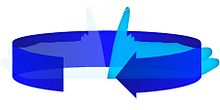
3D radar provides for radar ranging and direction in three dimensions. In addition to range, the more common two-dimensional radar provides only azimuth for direction, whereas the 3D radar also provides elevation. Applications include weather monitoring, air defense, and surveillance.
The information provided by 3D radar has long been required, particularly for air defence and interception. Interceptors must be told the altitude to climb to before making an intercept. Before the advent of single unit 3D radars, this was achieved with separate search radars (giving range and azimuth) and separate height finding radars that could examine a target to determine altitude. These had little search capability, so were directed to a particular azimuth first found by the primary search radar.
Techniques[edit]


Steered beam radars steer a narrow beam through a scan pattern to build a 3-D picture. Examples include NEXRAD Doppler weather radar (which uses a parabolic dish) and the AN/SPY-1 passive electronically scanned array radar employed by the Ticonderoga class of guided missile cruisers and other ships so equipped with the Aegis Combat System.
Stacked beam radars emit and/or receive multiple beams of radio waves at two or more elevation angles. By comparing the relative strengths of the returns from each beam, the elevation of the target can be deduced. An example of a stacked beam radar is the Air Route Surveillance Radar.
See also[edit]
- Type 984 radar, British aircraft carriers
- AN/TPS-75 US-made transportable PESA 3D air search radar
- Ghamar (3D radar)
External links[edit]
- "CEA FAR 3D Radar". Archived from the original on 2004-08-13. Retrieved 2004-10-31.
- "ESR 360L 3D Surveillance Radar". Archived from the original on 2006-09-23. Retrieved 2006-05-16.